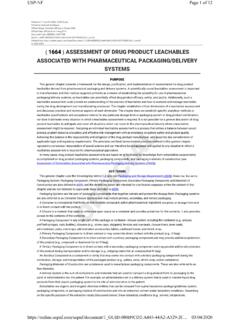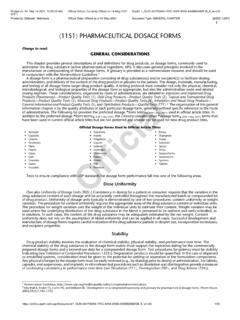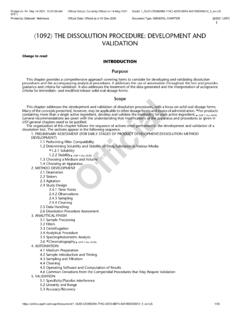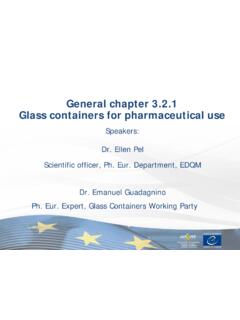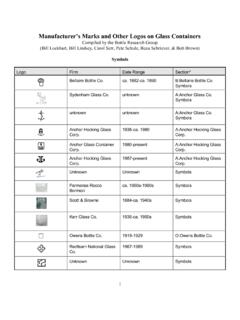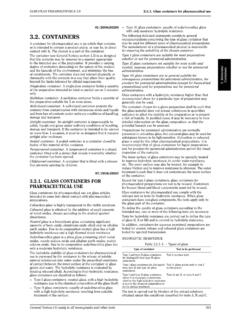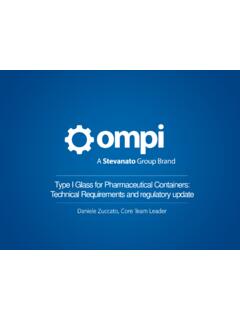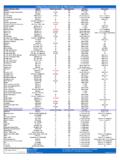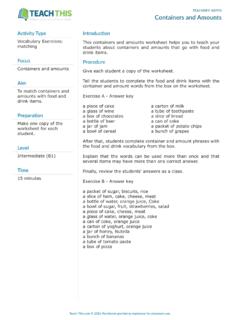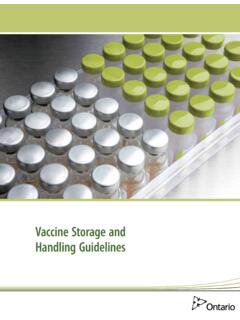Transcription of 660 〉〉 CONTAINERS—GLASS
1 Printed on: Fri Apr 03 2020, 16:41:29 pmPrinted by: Deborah NishikawaOfficial Status: Currently Official on 03-Apr-2020 Official Date: Official as of 1-May-2015 Document Type: GENERAL CHAPTERDocId: 1_GUID-67466D06-7 DCC-46C2-A61F-013D827120C6_1_en-USPrinte d from: 2020 USPC 660 containers glass DESCRIPTIONG lass containers for pharmaceutical use are intended to come into direct contact with pharmaceutical products. glass used for pharmaceutical containers is either borosilicate (neutral) glass or soda-lime-silica glass . Borosilicate glass contains significant amounts of boric oxide, aluminum oxide, and alkali and/or alkaline earth oxides in the glass network. Borosilicate glass has a high hydrolytic resistance and a high thermal shock resistance due to the chemical composition of the glass itself; it is classified as Type I glass . Soda-lime-silica glass is a silica glass containing alkaline metal oxides, mainly sodium oxide, and alkaline earth oxides, mainly calcium oxide, in the glass network.
2 Soda-lime-silica glass has a moderate hydrolytic resistance due to the chemical composition of the glass itself; it is classified as Type III glass . Suitable treatment of the inner surface of Type III soda-lime-silica glass containers will raise the hydrolytic resistance from a moderate to a high level, changing the classification of the glass to Type II. The following recommendations can be made as to the suitability of the glass type for containers for pharmaceutical products, based on the tests for hydrolytic resistance. Type I glass containers are suitable for most products for parenteral and nonparenteral uses. Type II glass containers are suitable for most acidic and neutral aqueous products for parenteral and nonparenteral uses. Type II glass containers may be used for alkaline parenteral products where stability data demonstrate their suitability. Type III glass containers usually are not used for parenteral products or for powders for parenteral use, except where suitable stability test data 1660.
3 This chapter also delamination. in opaque enclosure (see transmission. The glass Grains TestContainer TypeTestReasonI, II, IIIG lass Grains TestDistinguishes Type I borosilicate glass from Type II and III soda-lime-silica glassThe inner surface of glass containers is the contact surface for pharmaceutical preparations, and the quality of this surface is determined by the Surface glass Testfor hydrolytic resistance. The Surface Etching Testmay be used to determine whether high hydrolytic resistance is due to chemical composition or to surface treatement. Alternatively, the comparison of data from the glass Grains Testand the Surface glass Testmay be used in Table 2. Table 2. Determination of Inner Surface Hydrolytic ResistanceContainer TypeTestReasonPage 1 of 7 USP-NF03/04/2020 TypeTestReasonI, II, IIIS urface glass TestDetermines hydrolytic resistance of inner surface; distinguishes between Type Iand Type IIcontainers with high hydro-lytic resistance and Type IIIcontainers with moderate hydrolytic resistance I, IISurface Etching Testor comparison of glass Grains Testand Surface glass Testdata Where it is necessary, determines whether high hydrolytic resistance is due to inner surface treatment or to the che-mical composition of the glass contai-ners glass containers must comply with their respective specifications for identity and surface hydrolytic resistance to be classified as Type I, II, or III glass .)
4 Type I or Type II containers for aqueous parenteral products are tested for extractable arsenic. Hydrolytic ResistanceAPPARATUSA utoclave:For these tests, use an autoclave capable of maintaining a temperature of 121 1 , equipped with a thermometer, or a calibrated thermocouple device, allowing a temperature measurement independent of the autoclave system; a suitable recorder; a pressure gauge; a vent cock; and a tray of sufficient capacity to accommodate the number of containers needed to carry out the test above the water level. Clean the autoclave and other apparatus thoroughly with Purified Water before and pestle:Use a hardened-steel mortar and pestle, made according to the specifications in Figure 1. Figure 1. Mortar and pestle for pulverizing glass . Other apparatus:Also required are a set of three square-mesh stainless steel sieves mounted on frames consisting of US Sieve Nos. 25, 40, and 50 (see Particle Size Distribution Estimation by Analytical Sieving 786 , Table 1.)
5 Sizes of Standard Sieve Series in Range of Interest); a mechanical sieve-shaker or a sieving machine that may be used to sieve the grains; a tempered, magnetic steel hammer; a permanent magnet; weighing bottles; stoppers; metal foil ( , aluminum, stainless steel); a hot air oven, capable of maintaining 140 5 ; a balance, capable of weighing up to 500 g with an accuracy of g; a desiccator; and an ultrasonic dioxide-free water:This is Purified Water that has been boiled vigorously for 5 min or more and allowed to cool while protected from absorption of carbon dioxide from the atmosphere, or Purified Water that has a resistivity of not less than 18 2 of 7 USP-NF03/04/2020 red solution:Dissolve 50 mg of methyl red in mL of M sodium hydroxide and 50 mL of ethanol (96%), and dilute with Purified Water to 100 mL. To test for sensitivity, add 100 mL of carbon dioxide-free water and mL of M hydrochloric acid to mL of the methyl red solution. The resulting solution should be red.
6 NMT mL of M sodium hydroxide is required to change the color to yellow. A color change from red to yellow corresponds to a change in pH from pH (red) to pH (yellow). glass Grains TestThe glass Grains Testmay be performed either on the canes used for the manufacture of tubing glass containers or on the containers. SAMPLE PREPARATIONR inse the containers to be tested with Purified Water, and dry in the oven. Wrap at least three of the glass articles in clean paper, and crush to produce two samples of about 100 g each in pieces NMT 30 mm across. Place in the mortar 30 40 g of the pieces between 10 and 30 mm across taken from one of the samples, insert the pestle, and strike it heavily with the hammer once only. Alternatively, transfer samples into a ball mill-breaker, add the balls, and crush the glass . Transfer the contents of the mortar or ball mill to the coarsest sieve (No. 25) of the set. Repeat the operation until all fragments have been transferred to the sieve.
7 Shake the set of sieves for a short time by hand, and remove the glass that remains on sieves No. 25 and No. 40. Submit these portions to further fracture, repeating the operation until about 10 g of glass remains on sieve No. 25. Reject this portion and the portion that passes through sieve No. 50. Reassemble the set of sieves, and shake for 5 min. Transfer to a weighing bottle the glass grains that passed through sieve No. 40 and are retained on sieve No. 50. Repeat the crushing and sieving procedure with the second glass sample until two samples of grains are obtained, each of which weighs more than 10 each sample on a piece of clean glazed paper, and remove any iron particles by passing the magnet over them. Transfer each sample into a beaker for cleaning. Add 30 mL of acetone to the grains in each beaker, and scour the grains, using suitable means such as a rubber-tipped or plastic-coated glass rod. After scouring the grains, allow to settle, and decant as much acetone as possible.
8 Add another 30 mL of acetone, swirl, decant, and add a new portion of acetone. Fill the bath of the ultrasonic vessel cool in a desiccator. Filling and heating:50 mL of carbon Cool down to 100 at a rate of /min, venting to prevent formation of a vacuum, within 40 44 Do not open the autoclave until it has cooled to 95 .8. Remove the hot samples from the autoclave using appropriate safety precautions, and cool the samples cautiously down to room temperature within 30 min, avoiding thermal shock. Titration:To each of the three flasks add mL of Methyl red solution. Titrate the blank solution immediately with M hydrochloric acid, then titrate the test solutions until the color matches that obtained with the blank solution. Subtract the titration volume for the blank solution from that for the test solutions. Calculate the mean value of the results in mL of M hydrochloric acid per g of the sample. Repeat the test if the highest and lowest observed values differ by more than the permissible range given in Table 3.
9 Table 3. Permissible Range for Values ObtainedMean of the Values Obtained for the Consumption of Hydro-chloric Acid Solution per g of glass Grains (mL/g) Permissible Range of the Values ObtainedNMT of the meanPage 3 of 7 USP-NF03/04/2020 of the Values Obtained for the Consumption of Hydro-chloric Acid Solution per g of glass Grains (mL/g) Permissible Range of the Values of the meanNLT of the mean[NOTE Where necessary to obtain a sharp endpoint, decant the clear solution into a separate 250-mL flask. Rinse the grains by swirling with three 15-mL portions of carbon dioxide-free water, and add the washings to the main solution. Add mL of the Methyl red solution. Titrate, and calculate as before. In this case also add 45 mL of carbon dioxide-free Purified Water and mL of Methyl red solutionto the blank solution.]LIMITSThe volume does not exceed the values indicated in Table 4. Table 4. Test Limits for glass Grains TestFilling Volume (mL)Maximum Volume of M HCl per g of Test glass (mL)Type ITypes II and glass Testshoulder.
10 Vials and bottles:100 mL, and remove any dirt Cartridges and syringes:Luer cone or staked Vials and :Place at ). Read the capacities, Figure 2. Filling volumes of ampuls up to point A. Page 4 of 7 USP-NF03/04/2020 determination is carried out on unused containers. The volumes of the test solution necessary for the final determination are shown in Table 5. Table 5. Volume of Test Solution and Number of Titrations Filling Volume (mL) Volume of Test Liquid for One Titration (mL) Number of Titrations NMT 100 :Remove any debris or dust. Shortly before the test, rinse each container carefully at least twice with Purified Water, refilled, and allow to stand. Immediately before testing, empty the containers; rinse once with Purified Water, then with carbon dioxide-free water; and allow to drain. Complete the cleaning procedure from the first rinsing within 20 30 min. Closed ampules may be warmed in a water bath or in an air oven at about 40 for approximately 2 min before opening to avoid container pressure when opening.

